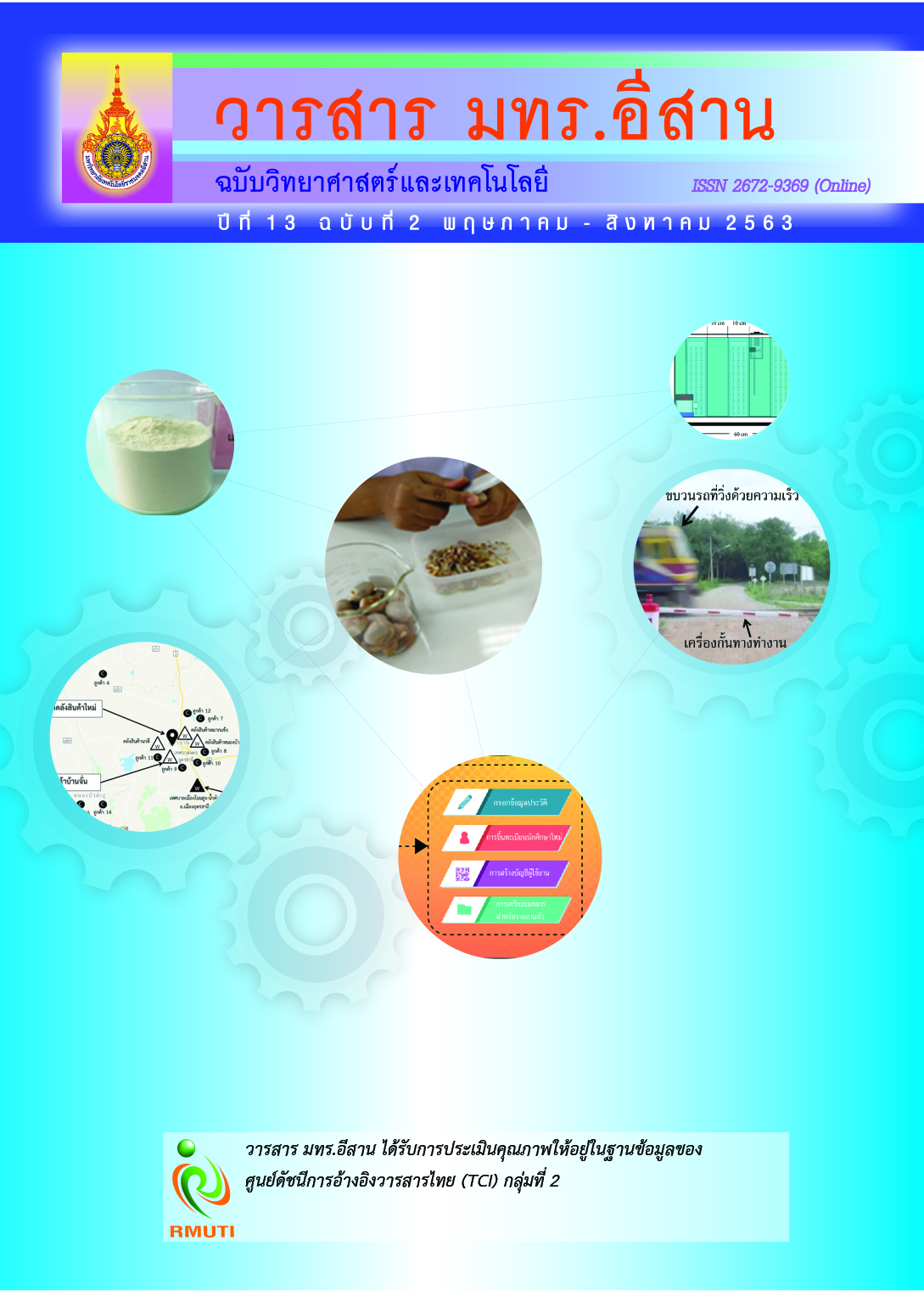Chlorella sp. Cultivation Using Carbon Dioxide Concentration Control System
Main Article Content
Abstract
The research aims to develop Chlorella sp. cultivation using a carbon dioxide concentration control system including to investigate the cultivation system of Chlorella sp. effecting on the growth rate. The cultivation system could control a pH range of cultivation between 6.7 and 6.9 leading to be appropriate with Chlorella sp.’s growth. In addition, the carbon dioxide concentration in water of cultivation correlates with acidity. Therefore, pH value in the cultivation system is regulated by filling the carbon dioxide concentration or the neutral water. The experimental result shows that the Chlorella sp. cultivation for the procedure, using the carbon dioxide concentration control system improving a pH value every 10 minutes, displays the 2.3 times of algal number density at last range of exponential phase. The algal number density under open-system is 1,015 × 103 cells/mL increasing to 2,322.5 × 103 cells/mL under the control system. In addition, an average growth rate increases to 1.7 times. The average growth rate under open-system is 195 × 103 cells/mL/day increasing to 333.47 × 103 cells/mL/day under the control system. Moreover, the cultivation with the carbon dioxide concentration control system could expand the range of growth in exponential phase explaining the appropriate environment for the Chlorella sp. cultivation.
Article Details
References
Sumriddetchkajorn, O. (2010). Fuel from Algae. Materials Technology Journal (National Metal and Materials Technology Center). Vol. 61, pp. 29-35
Leesing, R. and Nontaso, N. (2013). Biodiesel Production from High Lipid Green Microalgae Isolated from Treshwater in the Area of Khon Kaen Province. Research Report, Faculty of Science, Khon Kaen University
Ruangsomboon, S., Choochote, S., Taveekijakarn, P., and Ganmanee, M. (2012). Strain Selection and Mass Culture of High Lipid Content Algae for the Feasibility of Biofuel Production. Research Report, Faculty of Agricultural Technology, King Mongkut’s Institute of Technology Ladkrabang
Chamchoi, N. (2014). Microalgae: Cultivation and Utilization. HCU Journal. Vol. 34, pp. 169-183
Fleischer, C., Becker, S., and Eigenberger, G. (1996). Detailed Modeling of the Chemisorption of CO2 into NaOH in a Bubble Column. Chemical Engineering Science. Vol. 51, No. 10, pp. 1715-1724. DOI: 10.1016/0009-2509(96)00030-9
Singh, R. N. and Sharma, S. (2012). Development of Suitable Photobioreactor for Algae Production - A Review. Renewable and Sustainable Energy Reviews. Vol. 16, Issue 4, pp. 2347-2353. DOI: 10.1016/j.rser.2012.01.026
Richmond, A. (2004). Handbook of Microalgal Mass Culture. Iowa: Iowa State Press
Becker, E. W. and Venkatanaman, L. V. (1982). Biotechnology and Exploitation of Algae: The Indian Approach. Eschborn: German Agency for Technical Cooperation (GTZ). p. 216
Kumar, H. D. and Singh, H. N. (1979). A Textbook on Algae. London: The Macmillan Press Ltd
Choi, C. S., Choi, W. Y., Kang, D. H., and Lee, H. Y. (2014). Production of Biodiesel from Chlorella sp. Enriched with Oyster Shell Extracts. BioMed Research International. Vol. 2014, No. 105728, pp. 1-8. DOI: 10.1155/2014/105728
Choochote, W. (2013). Antibacterial Activity of Chlorella spp. Extract against Pathogenic Bacteria. Journal of Science Ladkrabang. Vol. 22, No. 2, pp. 102-114
Sri-uam, P., Linthong, C., Powtongsook, S., Kungvansaichol, K., and Pavasant, P. (2015). Manipulation of Biochemical Compositions of Chlorella sp. Engineering Journal. Vol. 19, No. 4, pp. 13-24. DOI: 10.4186/ej.2015.19.4.13
Steenblock, D. (1987). Chlorella Natural Medicinal Algal. California: Aging Research Institute
Yamali, Y., Phoopat, S., Sutjaritvongsanon, K., Yongmanitchai, W., and Patarakulpong, P. (1984). Utilization of Chlorella sp. from Waste Water in Soy-Milk Plant for Feeding on Moina Macrocopa. In Proceedings of the 22nd Conference: Fisheries Section. Bangkok, Kasetsart University. pp. 396-402
Shi, J., Podola, B., and Melkonian, M. (2007). Removal of Nitrogen and Phosphorus from Wastewater Using Microalgae Immobilized on Twin Layers: An Experimental Study. Journal of Applied Phycology. Vol. 19, pp. 417-423. DOI: 10.1007/s10811-006-9148-1
Borowitzka, M. A. (1999). Commercial Production of Microalgae: Ponds, Tanks, Tubes and Fermenters. Journal of Biotechnology. Vol. 70, pp. 313-321
Bošnjaković, M. (2013). Biodiesel from Algae. Journal of Mechanics Engineering and Automation. Vol. 3, Number 3, pp. 179-188
Kaikha, S. (2016). The Effect of LED Lighting on the Growth Rate of Chlorella sp. B.Sc. Dissertation School of Renewable Energy, Maejo University
Wisansuwannakorn, R. (2005). Optimal Conditions for Growth of Chlorella sp. by Using Carron Dioxide as a Corbon Source in Photobioreactor. M.Sc. Dissertation, Faculty of Science, Chulalongkorn University
Raksasak, W., Pichiansoontorn, Y., Panyapinyopol, B., Malakul, P., and Pavasant, P. (2012). Accelerating Microalgal Growth with CO2 Transformation. Engineering Journal. Vol. 4, pp. 15-26


